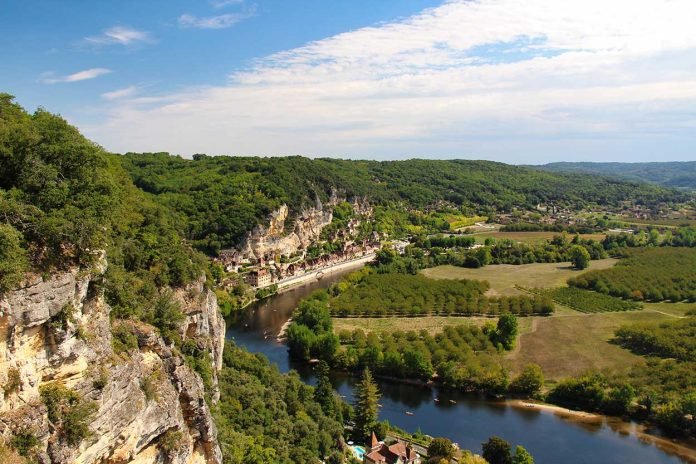Every corner of France sings a different song. Among these regional melodies, one echoes uniquely through the ages, charming both locals and tourists alike – the captivating hymn of Nouvelle-Aquitaine.
In France’s southwestern corner, Nouvelle-Aquitaine is France’s largest region, offering visitors a variety of experiences that span centuries and continents. Its history is intertwined with the earth’s formation, human evolution, and the rise and fall of civilizations. This, along with the region’s natural wonders, makes Nouvelle-Aquitaine an irresistibly diverse travel destination.
Top 10 Marvels of Nouvelle-Aquitaine
- The sublime Bordeaux wine regions, world-renowned for their superior viniculture.
- The historic and picturesque town of Biarritz, a surfer’s haven on the Bay of Biscay.
- The verdant and tranquil Dordogne Valley, adorned with prehistoric sites and captivating medieval towns.
- The breathtaking Landes de Gascogne Regional Natural Park, a sanctuary for nature enthusiasts.
- The region’s culinary repertoire, showcasing cassoulet, divine truffles, and other gastronomic marvels.
- The culture-rich city of Poitiers, offering a treasure trove of Romanesque art and architecture.
- La Rochelle’s ancient port, a preserved testament to the region’s vibrant maritime history.
- The towering Dune du Pilat, Europe’s tallest sand dune and a spectacle to behold.
- The opulent city of Bordeaux, defined by its graceful public gardens and grandiose 18th-century architecture.
- The Lascaux caves, the prehistoric masterpiece housing cave paintings dating back 17,000 years.
Highlights of Nouvelle-Aquitaine
Wine and More in Bordeaux
In Bordeaux, the world-renowned wine region, history, and culture blend with exceptional grace. With a tradition that dates back to the 8th century, the art of winemaking here is an integral part of life and a heritage cherished by locals and visitors alike. The vineyards stretch as far as the eye can see, each one producing its unique blend of wines, mirroring the diversity of the region.
Guided tours offer immersive experiences, taking visitors from the vineyard to the cellar, explaining the intricate process of transforming grapes into the world-class wines that have come to define Bordeaux. It’s not just the wines that captivate but also the stunning wine châteaux. They stand as testament to the region’s prosperous past and present, offering a scenic backdrop to the vineyards.
Apart from wine, Bordeaux city itself is a jewel worth exploring. With its elegant boulevards, charming squares, and breathtaking architecture, Bordeaux is an urban landscape steeply rooted in history. The city’s numerous public gardens, bustling marketplaces, and lively cafés offer a taste of the quintessential French lifestyle.
A Surfing Paradise: Biarritz
Biarritz, beautifully situated along the Bay of Biscay, offers a mix of history, culture, and natural beauty. Once a small whaling town, Biarritz transformed into a popular seaside resort in the 19th century. Today, it is recognized as Europe’s surfing capital, attracting surfers from around the world with its challenging waves and stunning coastline.
Apart from the surf culture, Biarritz’s architectural gems are worth exploring. From its ornate villas to the iconic lighthouse and the Russian Orthodox Church, the town is a blend of architectural styles that reflect its colorful past. The Museum of the Sea, which houses a significant collection of marine species, offers insight into the town’s deep connection with the ocean.
Walking through Biarritz is like stepping into a picturesque postcard. The rugged coastline, dotted with sandy beaches and craggy cliffs, frames the vibrant town. The town’s scenic beauty, combined with its lively markets and gastronomic scene, makes Biarritz an unforgettable destination.
The Timeless Dordogne Valley
The Dordogne Valley is a step back in time, with its prehistoric caves, medieval towns, and castles perched on cliff tops. It offers visitors a unique blend of natural beauty and history. The region is particularly known for the Lascaux caves, a UNESCO World Heritage Site. The caves, often called the ‘Sistine Chapel of Prehistoric Art’, feature paintings over 17,000 years old and offer a glimpse into our ancient past.
Aside from its prehistoric art, the Dordogne is also known for its enchanting medieval towns, including Sarlat-la-Canéda. With its cobblestone streets and Gothic and Renaissance architecture, Sarlat seems untouched by time. Its vibrant markets, where one can sample the region’s culinary delights, add to its charm.
The natural beauty of the Dordogne is unparalleled. The valley, with its verdant forests, dramatic cliffs, and winding river, offers stunning landscapes that change with the seasons. Whether you’re exploring the valley by canoe, on foot, or from the comfort of a traditional gabare (river boat), the Dordogne is a feast for the senses.
Natural Wonders and National Parks
A Biosphere Reserve: Landes de Gascogne Regional Natural Park
Stretching from the southern tip of Bordeaux to the northern edge of the Pyrénées, the Landes de Gascogne Regional Natural Park is an environmental treasure. Its diverse landscape, which includes forests, wetlands, and lakes, is a haven for numerous bird species and a delight for nature lovers.
The park is crisscrossed with a network of trails that allow visitors to explore its unique flora and fauna. Whether you prefer hiking, cycling, or horseback riding, the park offers a variety of ways to immerse yourself in its natural beauty. For those who prefer a leisurely pace, the park’s picnic spots and campsites provide opportunities to relax and enjoy the tranquility.
Designated as a UNESCO Biosphere Reserve, the park also has an educational mission. Several visitor centers located within the park offer interactive exhibitions, guided tours, and workshops, aimed at raising awareness about the importance of biodiversity and sustainable development.
The Majestic Dune du Pilat
The Dune du Pilat, located in the heart of the Landes de Gascogne, is Europe’s tallest sand dune. Standing over 100 meters tall, this natural marvel offers panoramic views of the Atlantic Ocean, the Arcachon Bay, and the surrounding pine forest. The sight from the summit, especially at sunrise or sunset, is a spectacle not to be missed.
Hiking up the dune can be a challenge, but it’s worth the effort. The dune’s ever-changing shape, sculpted by the winds, offers a unique experience with every visit. For the more adventurous, paragliding from the summit provides a thrilling way to enjoy the view.
Despite its popularity, the Dune du Pilat remains a preserved natural site. Efforts are underway to protect and maintain this delicate ecosystem, making it a model of sustainable tourism.
A Gastronomic Journey
Nouvelle-Aquitaine’s gastronomy is a testament to its rich and varied landscapes. Its hearty cassoulets, divine truffles, succulent lamb, fresh seafood, and sweet pastries reflect the region’s agricultural abundance and culinary creativity.
In addition to the famous Bordeaux wines, the region is known for its Armagnac, a distinguished brandy produced in Gascony. The black Périgord truffle, a rare and prized delicacy, is another gastronomic icon of the region. Truffle hunting tours offer a unique experience that combines nature and gastronomy.
The region’s seafood deserves a special mention. Oysters from Arcachon Bay are considered some of the best in France. Enjoying these briny bivalves with a glass of chilled white Bordeaux by the seaside is a quintessential Nouvelle-Aquitaine experience.
A Rich Cultural Heritage
Nouvelle-Aquitaine is a region steeped in history, with an architectural heritage that spans from the Romanesque period to the Belle Époque. Its cities and towns, each with its unique character, offer a glimpse into the region’s past.
Poitiers, known for its impressive collection of Romanesque architecture, is a must-visit. The city’s Saint-Pierre Cathedral and the Church of Sainte-Radegonde are architectural marvels that transport visitors back to the Middle Ages.
The city of Bordeaux, with its elegant squares, wide boulevards, and 18th-century buildings, is a UNESCO World Heritage Site. The city’s public gardens, designed in the English style, offer peaceful retreats within the urban landscape.
La Rochelle, with its fortified old port, towers, and half-timbered houses, is another architectural gem. The city’s maritime history is palpable, with its bustling harbor, maritime museum, and annual nautical events.



















